
Search Wild Foods Home Garden & Nature's Restaurant Websites:
Cherries & Plums
Contents On This Page:
- Black Cherry
- Chokecherry
- Pin Cherry
- Sand Cherry
- Sour Cherry
- Sweet Cherry or Wild Cherry
- Canada Plum or Black Plum
- American Plum or Wild plum
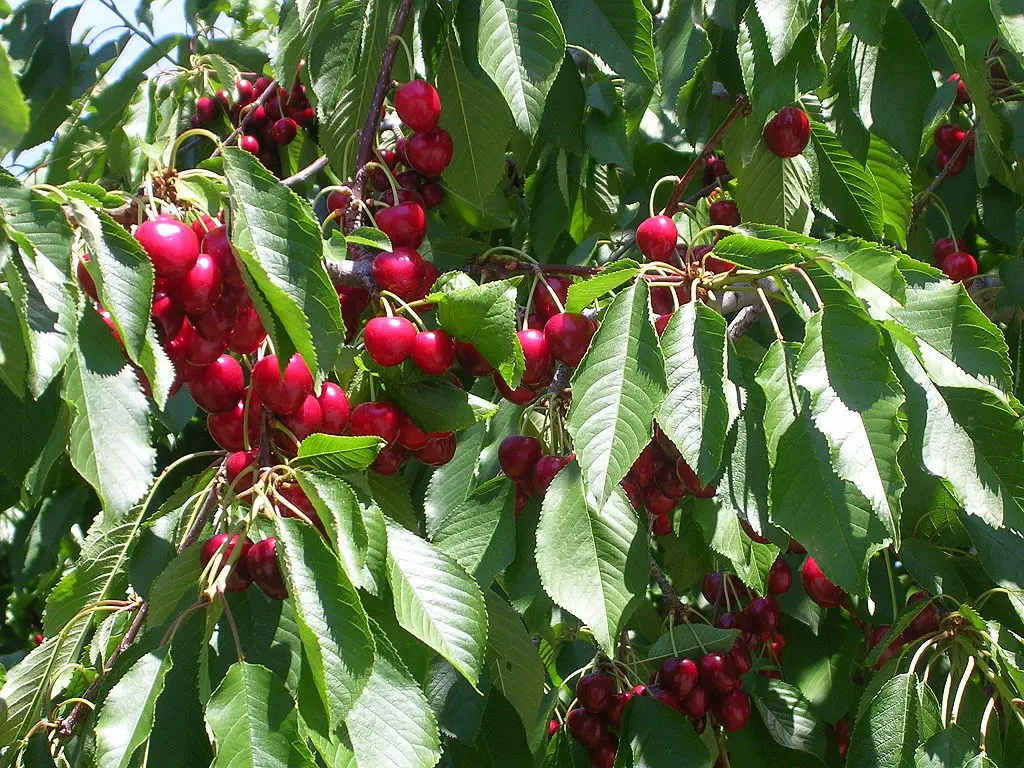
(By: Clayoquot GNU Free Documentation License, Version 1.2)
(NOTE: If you are not interested in growing Cherry or Plum trees, but just finding the fruit, try going to the Nature's Restaurant Online site for Cherries & Plums.)
This is a vast subject: There are the native species and introduced European and Asian species - many of those grow naturalized in North America. There are hybrids of different species, and variations within species. For example, with just the Sand Cherry, there are four recognized varieties.
Cherries are in the Prunus family which includes Cherry, Plum, Peach, Nectarines, Apricot and Almond. Native to the area I'm from are three Cherries, and two Plums. Plus, there are introduced varieties of Sweet and Sour Cherry and Plums.
With many in this group you can buy trees at the local nurseries. With many, transplanting those other than ones bought in containers often doesn't work well. The exception is those that form clonal colonies like the Sand Cherry. Most species require two trees so there will be cross pollination, but there are cultivars that are self pollinating. This is one group that I recommend buying from a reputable nursery, though you can plant pits from wild ones. If you do buy from a nursery, follow their instructions for planting and care.
Soil & Site: In general Cherries and Plums do best on well drained, rich soil. They don't like to be in soaking wet soils or where there is standing water even in the spring - except for the American Plum which does like wet land.
Planting: Because there are so many types of Cherry and Plum trees, and with almost all there are many cultivars including dwarf cultivars, my suggestion with these trees is to buy smaller ones from a local reputable nursery that can help you decide on the right one for your area, site and fruit requirements. Be prepared to tell them what kind of soil you have, and follow their instructions for planting.
Seeds: If you have the right soil, and want to start them from pits, I would suggest trying to find Cherries or Plums from trees that are growing locally. If you get Cherries or Plums in a store and try to plant the pits, they may not do well if they came from a different climate. Keep in mind, there are dozens of hybrids, grafted trees and dwarf variations that you might find planted or in nurseries. Pits from some of these might not grow as well as the parent trees - if at all - because pits from hybrids can be sterile, and pits from grafted trees might not have rootstock that is hardy in your area. Because of this, get pits from trees that are growing wild, or from planted trees you can verify are not hybrids or grafted.
Maintenance: In general, they don't require much mulch, but do require moisture all season long, so don't let them fully dry out in a drought. Unless the soil is very poor, they don't require fertilizing.
Harvesting: Harvesting is straight forward, but I just want to note that you might need to put bird nets over your trees before the fruit starts to ripen, or you might as well just consider them living bird feeders.
Below are descriptions of the ones you would be likely to find growing locally in the wild.
Black Cherry
Black Cherry (Prunus serotina). Native to Eastern North America. Can be a large tree, and usually very straight. There is one central leaf vein from the stem to tip with side veins coming off, sweeping toward the tip. The twigs are thin and reddish brown. The Cherry is about a centimeter (3/8 inch) diameter and has a five star shaped calyx (remnants of flower pedals) that stays with the Cherry, and is large for the Cherry's size - a distinguishing feature. The short stemmed, almost black Cherries come off the twigs in singles - not hanging in doubles like the image most think of with Cherries. Expect to find Cherries in August and early September. Fruit is good, with a slight bitter edge.
I don't know if you can buy this exact species from most nurseries, but you certainly could plant the pits from the cherries if you find them in the wild. With this one, it will take a few years before you get a harvest, unlike some that produce fruit very quickly. However, this is a long living tree and you will be doing a service to others in the future. Nice tree.
Description:
- USDA Plant Hardiness Zone: 3-9 (More information on hardiness zones).
- Soil pH: 5.0-7.5
- Plant Size: Large tree up to 21 meters (70 feet) tall
- Duration: Although most Cherry trees have a relatively short life span (20 years), this one can live over 100 years, and has been known to live 250 years
- Leaf Shape: Leaves are a narrow Ovate
- Leaf Phyllotaxis (Arrangement) on branch: Alternate
- Leaf Size: 7-13cm (3 to 5 inches) long
- Leaf Margin: Serrated (saw toothed edge)
- Leaf Notes: Leaf veins sweep toward tip
- Flowers: Small five petalled flowers on a raceme that has around 40 flowers each
- Fruit: Very dark red, on short stems, 1 cm (3/8 inch) diameter, five star shaped calyx (remnants of flower pedals) that stays with the Cherry
- Bark: On younger trunks or branches the bark can be a reddish brown to grey with very distinct horizontal lenticels (checking), on mature trunks, the bark is dark grey to black with some reddish tones on the newer bark in the crevices. The older bark is broken into plates, and often you can seen on the outermost plates the lenticels (checking). I have seen trunks of this tree many times where there are sections that still have the smoother bark with lenticels and sections where it is broken up into the plates, often with the smoother bark peeling back and giving way to the rough, broken up mature bark.
- Habitat: Found mainly where there are Deciduous forests in Eastern North America, usually on good soils.
Web Resources:
- Recipe search on the web here (Google search) and here (Bing search).
- Pictures on the web here (Google images) and here (Bing images).
- Interactive USDA distribution map and plant profile here.
- The Biota of North America Program (BONAP) distribution map here. BONAP map color key here.
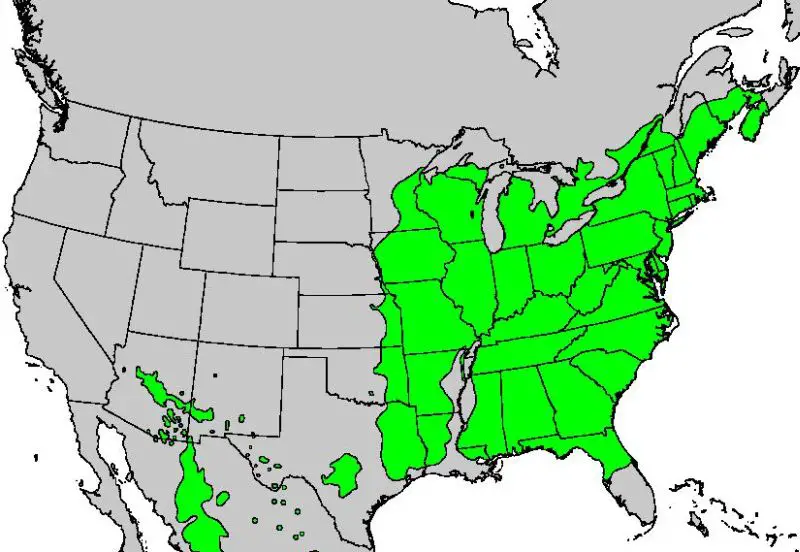
Black Cherry (Prunus serotina) range. Distribution map courtesy of the USGS Geosciences and Environmental Change Science Center, originally from "Atlas of United States Trees" by Elbert L. Little, Jr. .
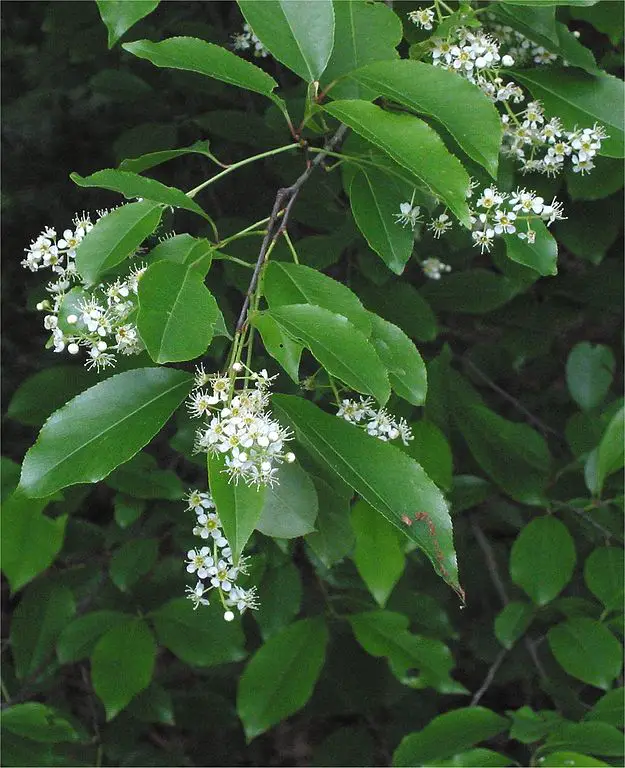
Black Cherry (Prunus serotina) leaves and flowers. (By: Rasbak GNU Free Documentation License, Version 1.2)
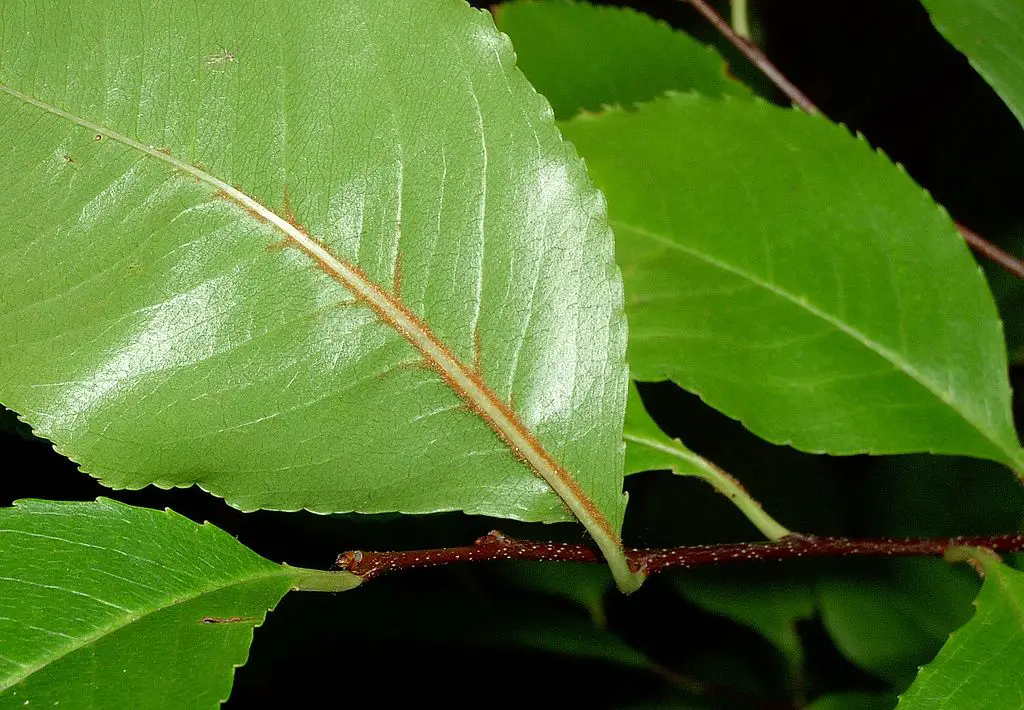
Black Cherry (Prunus serotina) leaf and twig up close. (By: Krzysztof ZIarnek, Kenraiz CC BY-SA 3.0)
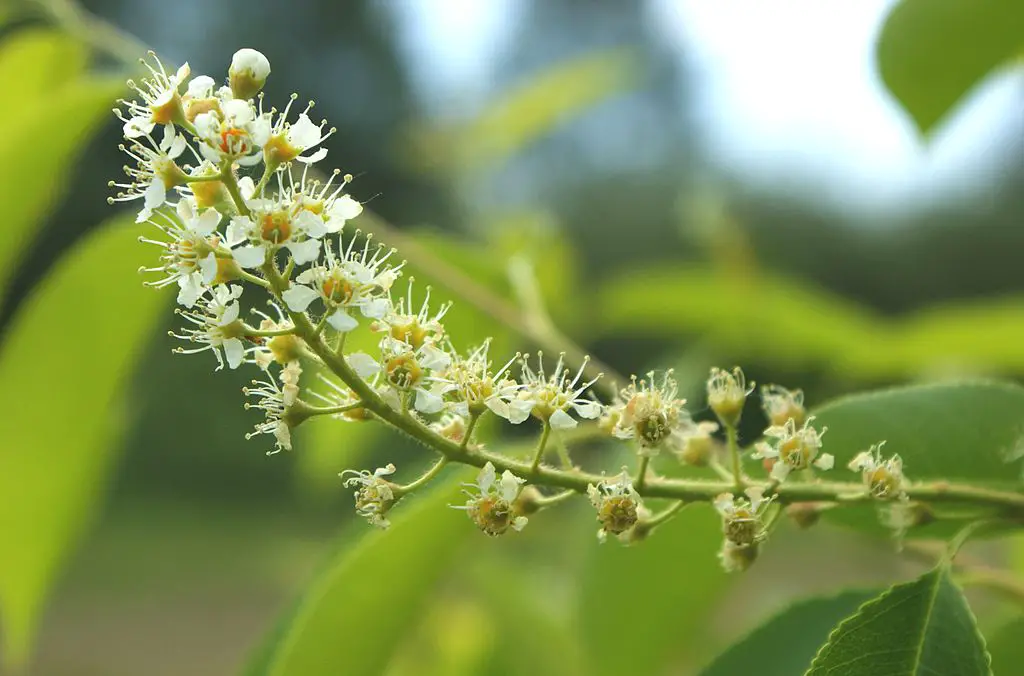
Black Cherry (Prunus serotina) flower up close. (By: Krzysztof ZIarnek, Kenraiz CC BY-SA 3.0)
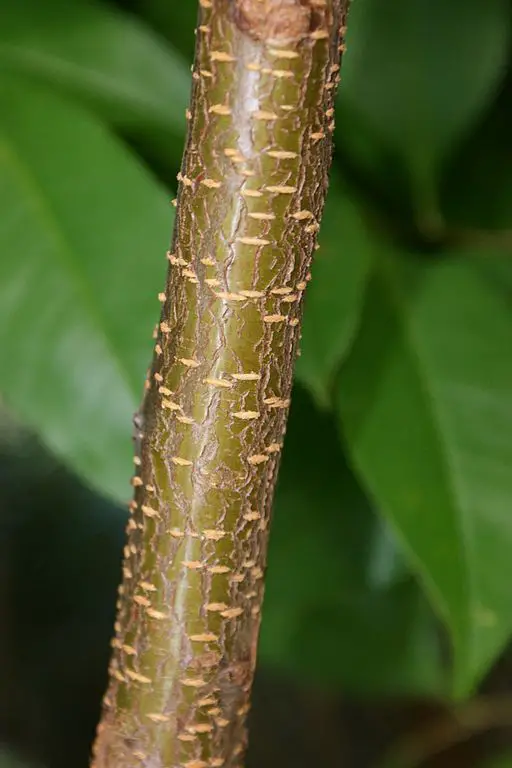
Black Cherry (Prunus serotina) young tree bark. (By: Kenraiz CC BY-SA 3.0)
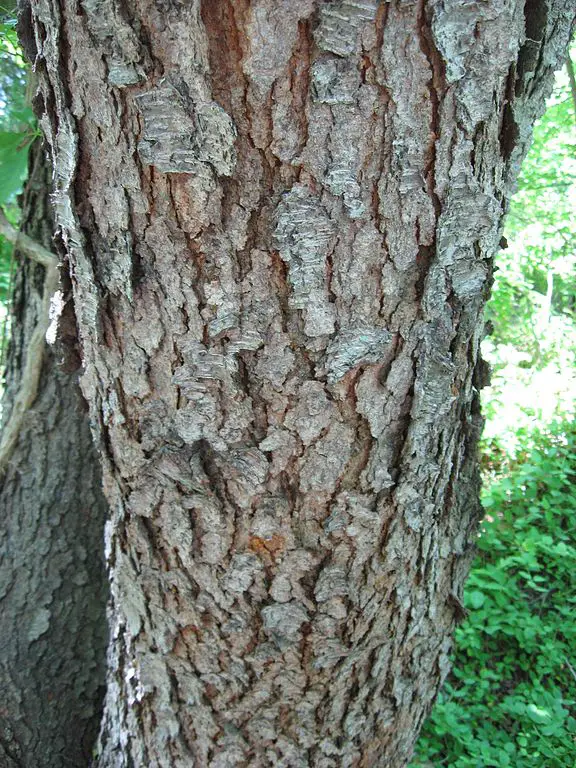
Black Cherry (Prunus serotina) mature tree bark. (By: Chhe)
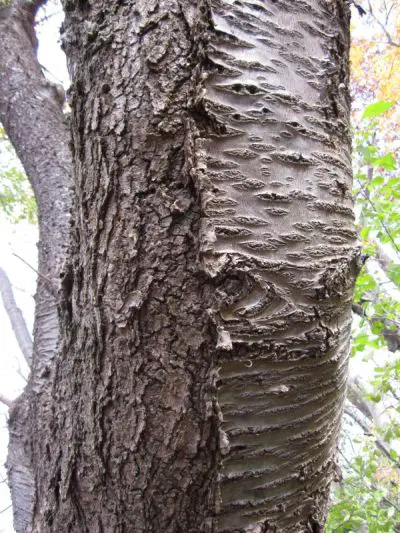
This is a good example of the transition from the smoother bark with horizontal lenticels (checking) on the right side, to the mature bark that is broken up into plate-like areas.
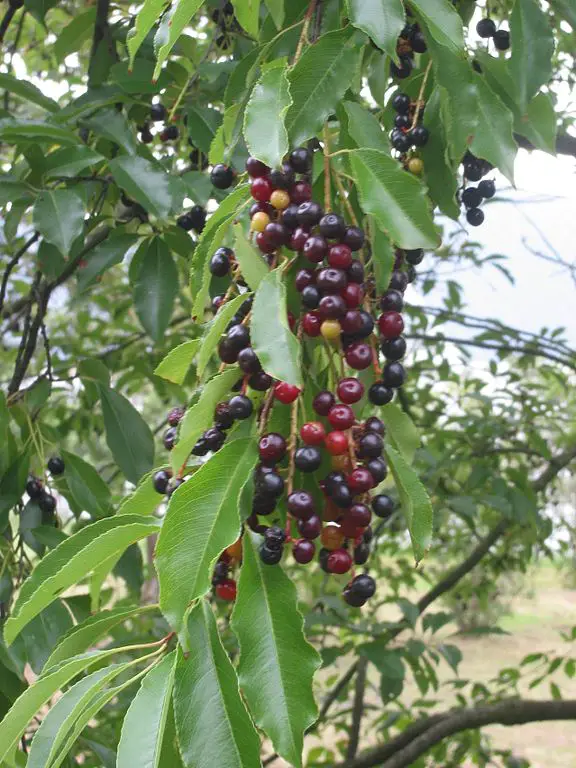
Black Cherry (Prunus serotina) leaves and cherries. (By: Rasbak GNU Free Documentation License, Version 1.2)
Black Cherry (Prunus serotina) fall colors. (By: Famartin Attribution-Share Alike 4.0 International license)
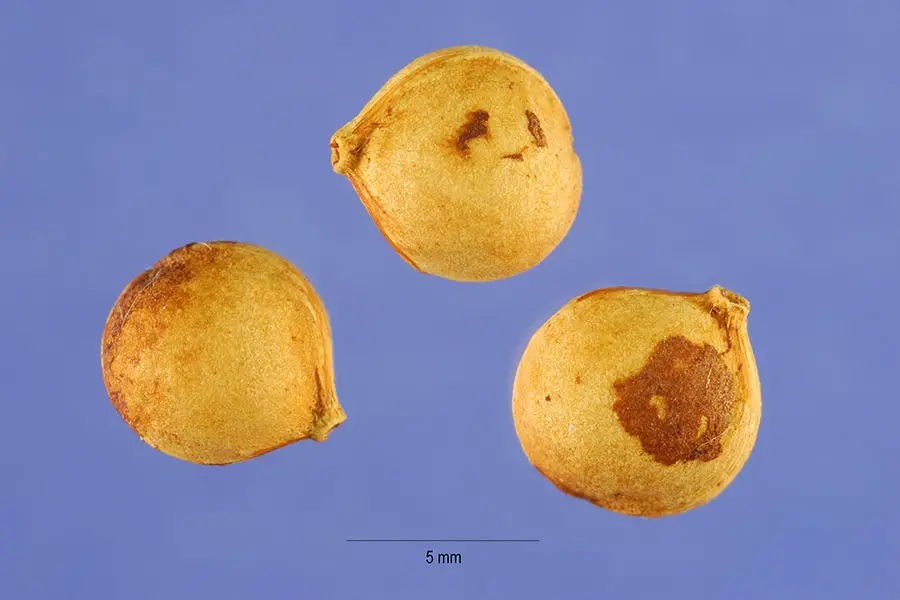
Black Cherry (Prunus serotina) seeds/pits. (Steve Hurst, hosted by the USDA-NRCS PLANTS Database)
Chokecherry
Chokecherry (Prunus virginiana). Native to North America. A multi-stemmed bush or small tree found in open areas, often at the edges of forests, along old fences, by streams or where land has been cleared many years before and left - abandoned fields. Not in woods, as it will die in shade. Cherry is about 3/8 inch diameter, dark red to blackish, and appears to have no flower parts remaining (very, very small remnants). Sharp and dry tasting, but I like it - makes your mouth pucker! Fruits in August and early September. Clusters of cherries come from near ends of twigs, in one per attachment to cluster (not pairs).
Although this is not a favorite cherry to eat raw, it makes for very good jams & jellies, as well as being good for baked deserts.
You can buy various versions of this tree at nurseries, such as the red leaved "Canada Red Chokecherry", or easily grow from a pit from a cherry found in the wild. They grow fast from the pit. This tree or large shrub, likes to grow suckers from the ground at the base of the trunk. If you want a shrub like plant, no problem. If you want a single trunk "tree" like version of this, it can be done, but you will have to cut off the suckers every year - at least once per year.
Description:
- USDA Plant Hardiness Zone: 2-7 (More information on hardiness zones).
- Soil pH: 6.0-7.6
- Plant Size: Small tree or large Shrub that grows up to 5 meters (16 feet) high
- Duration: Can live up to 40 years, or slightly longer
- Leaf Shape: Ovate
- Leaf Phyllotaxis (Arrangement) on branch: Alternate
- Leaf Size: 7-10cm (3 to 4 inches) long
- Leaf Margin: Serrated (saw toothed edge)
- Leaf Notes: The leaves are an uneven oval - fattest part about 1/3 way down from tip with obvious pointed tip
- Flowers: White flowers in racemes of 15 to 30 flowers
- Fruit: 1 cm (3/8 inch) diameter, bright red to blackish. Sharp, astringent to bitter taste.
- Bark: This is the one Cherry that does not have the very thin grey skin like coating on young twigs.
- Habitat: Full sun. Dry, exposed sites down to zone 2, very common in open areas in boreal forest regions.
Web Resources:
- Recipe search on the web here (Google search) and here (Bing search).
- Pictures on the web here (Google images) and here (Bing images).
- Interactive USDA distribution map and plant profile here.
- The Biota of North America Program (BONAP) distribution map here. BONAP map color key here.
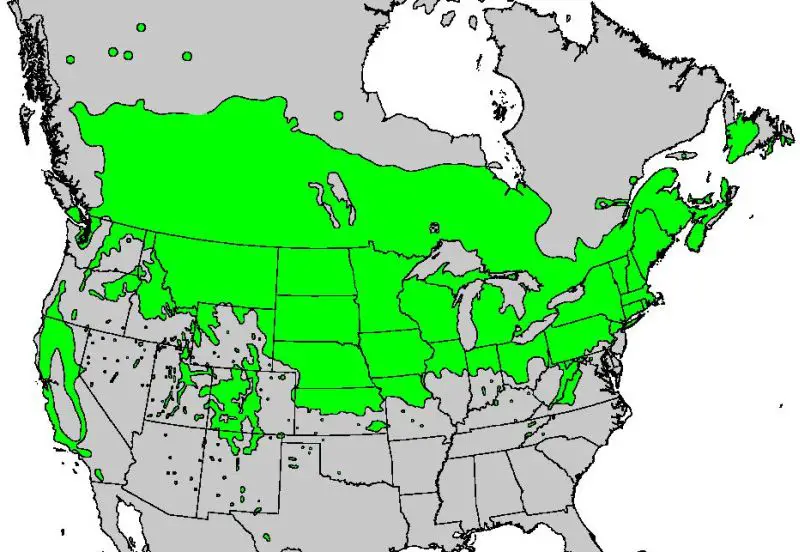
Chokecherry (Prunus virginiana) range. Distribution map courtesy of the USGS Geosciences and Environmental Change Science Center, originally from "Atlas of United States Trees" by Elbert L. Little, Jr. .
_BLM.jpg)
Chokecherry (Prunus virginiana) leaves and flowers. (USDA-NRCS PLANTS Database)
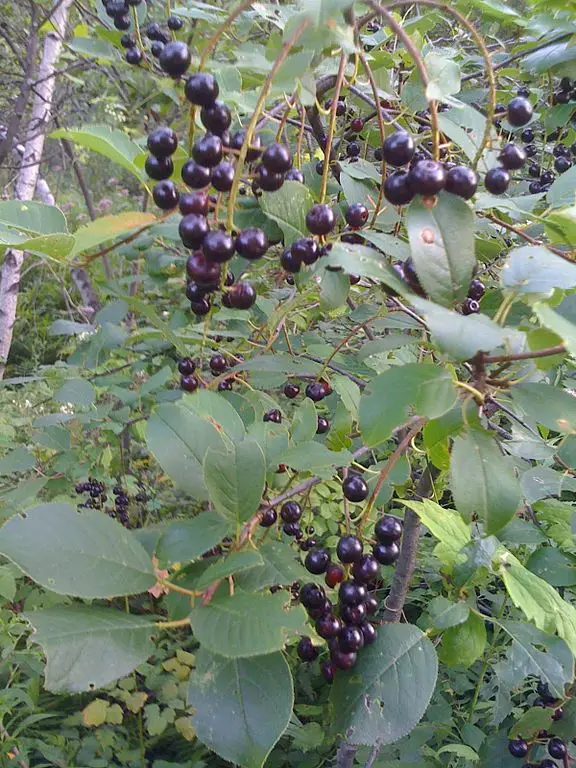
Chokecherry (Prunus virginiana). The color of the cheries can range from purplish-black to red. These are a good example of the purplish-black cheries. (By: Charles de Mille-Isles Attribution 2.0 Generic)
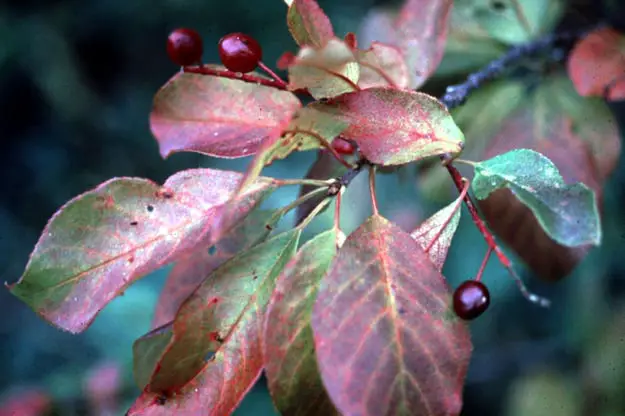
Chokecherry (Prunus virginiana). These are an example of red ones. (By: National Park Service, USA)
Chokecherry (Prunus virginiana) fall colors. (By: Famartin Attribution-Share Alike 4.0 International license)
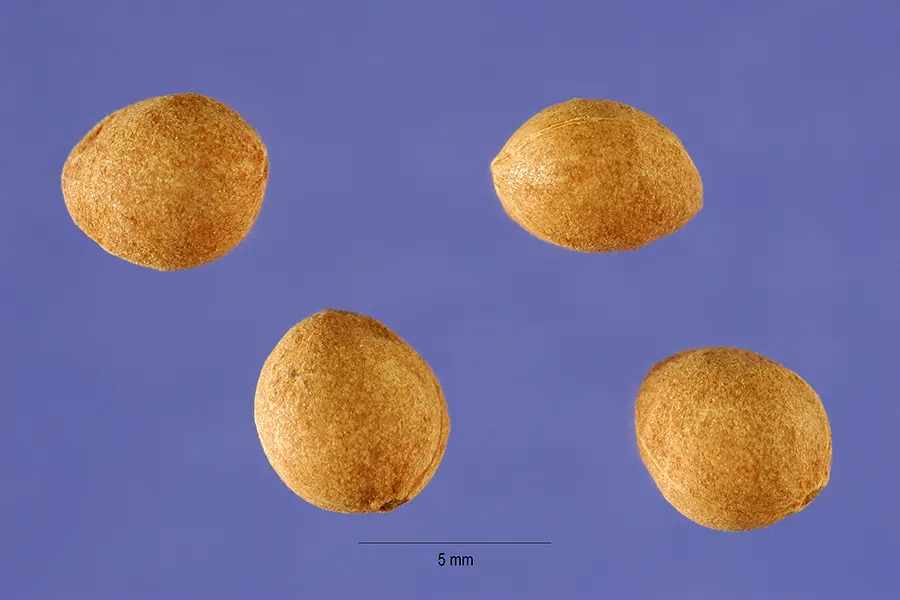
Chokecherry (Prunus virginiana) seeds/pits. (By: Steve Hurst, hosted by the USDA-NRCS PLANTS Database)
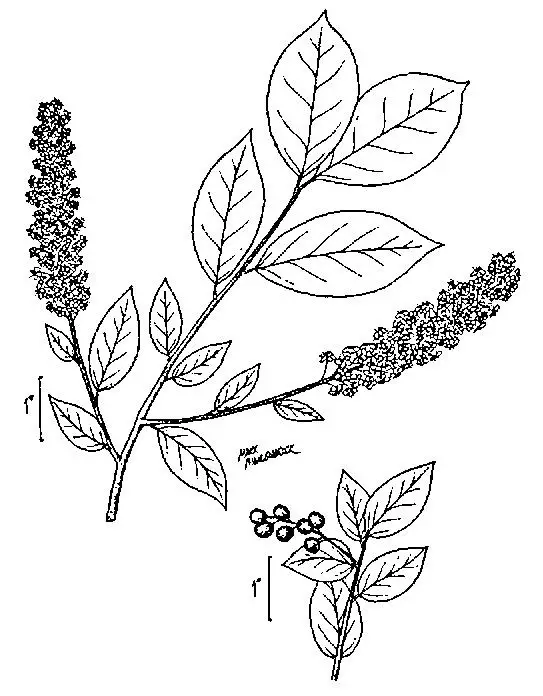
Chokecherry (Prunus virginiana) drawing. (USDA-NRCS PLANTS Database / USDA NRCS. Wetland flora: Field office illustrated guide to plant species. USDA Natural Resources Conservation Service.)
Pin Cherry
Pin Cherry (Prunus pensylvanica). Native to North America. Expect to find this one in open areas, or areas that were cleared years ago and left. Has a single or multiple trunk, can grow up to 50 feet tall or more, with a trunk no bigger than a foot across. The bark is distinctive, and a very good way of distinguishing it from other cherry trees. It has smooth bark (unless tree is very mature) that is reddish brown, with widely spaced horizontal lenticels (checking) - powdery orange in color. The Cherry is sour, but I like it. It is very good for cooking with, and I understand it is starting to be grown commercially. August and early September for the Cherry. When I lived in Central Ontario, these were one of the first trees to take over cleared or burned land. They can grow very fast, and develop thick horizontal roots that seem well adapted to growing in thin soils on bedrock. Soon though, conifers would come in and shade them out. They were very happy to take over the clearings under power lines. Obviously, birds play a role in spreading these, as they always seemed to pop up right under where birds would perch - like under the utility lines, or along fences.
Not the best tasting cherry uncooked to most people's taste, but a very good cooked cherry in any recipe that would use "sour" cherries. Due to their small size, there is more work per volume of cherries in gathering than with other sour species.
I doubt that most nurseries would carry this tree, but if you can find some cherries from this tree in the wild and plant them, you will have a good sized tree very fast. You can prune it to conform to the shape you want, and the foliage is very nice looking. It doesn't live long, but makes up for that with the incredible speed it grows at.
Description:
- USDA Plant Hardiness Zone: 2-8 (More information on hardiness zones).
- Soil pH: 5.0-6.0
- Plant Size: Tree, up to 15 meter (50 feet) tall normally, but have been known to grow to 30 meters (100 feet)
- Duration: Fast growing, short lived tree that lives 20 to 40 years
- Leaf Shape: uneven Ovate, fattest near the stem end, then tapering to a long, pointed tip.
- Leaf Phyllotaxis (Arrangement) on branch: Alternate
- Leaf Size: 5-10 cm (2 to 4 inches)
- Leaf Margin: Finely Serrated (saw toothed edge)
- Leaf Notes: shiny yellow-green
- Flowers: 1 cm (3/8 inch) diameter white flowers grow in groups of 5 to 7
- Fruit: Up to 6 mm (1/4 inch) diameter Cherry, on a long stalk (stem) and bright red.
- Bark: Smooth bark (unless tree is very mature) that is reddish brown, with widely spaced horizontal lenticels (checking) - powdery orange in color
- Habitat: Varies greatly, but does well in burned areas, clearings. Wet to dry soil, does well where the soil is thin over bedrock. Often seen under power lines and in clearings in northern woods. Tolerates cold very well, often found growing quickly in conifer or boreal forest clearings that have been logged or burnt. Conifers eventually shade it out and take over, but by that time, its life span is basically over.
Web Resources:
- Recipe search on the web here (Google search) and here (Bing search).
- Pictures on the web here (Google images) and here (Bing images).
- Interactive USDA distribution map and plant profile here.
- The Biota of North America Program (BONAP) distribution map here. BONAP map color key here.
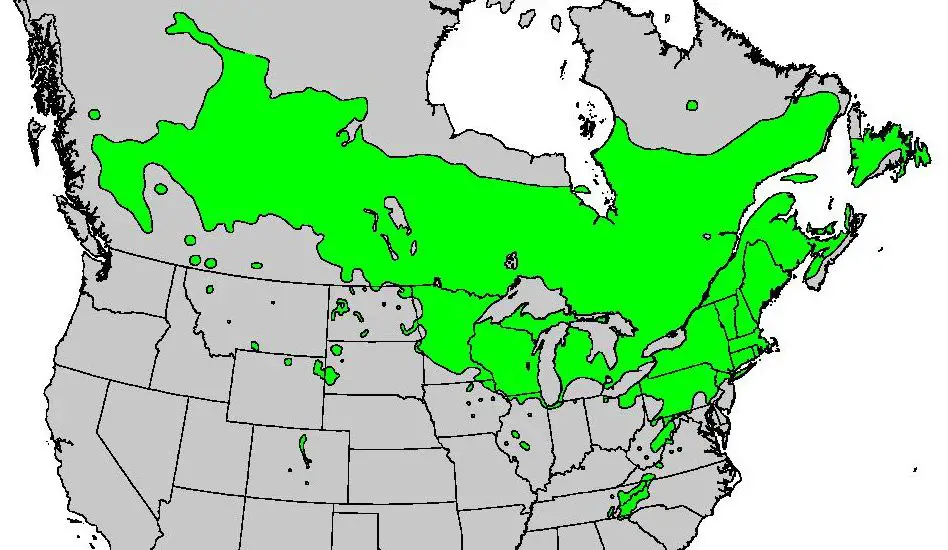
Pin Cherry (Prunus pensylvanica) range. Distribution map courtesy of the USGS Geosciences and Environmental Change Science Center, originally from "Atlas of United States Trees" by Elbert L. Little, Jr. .
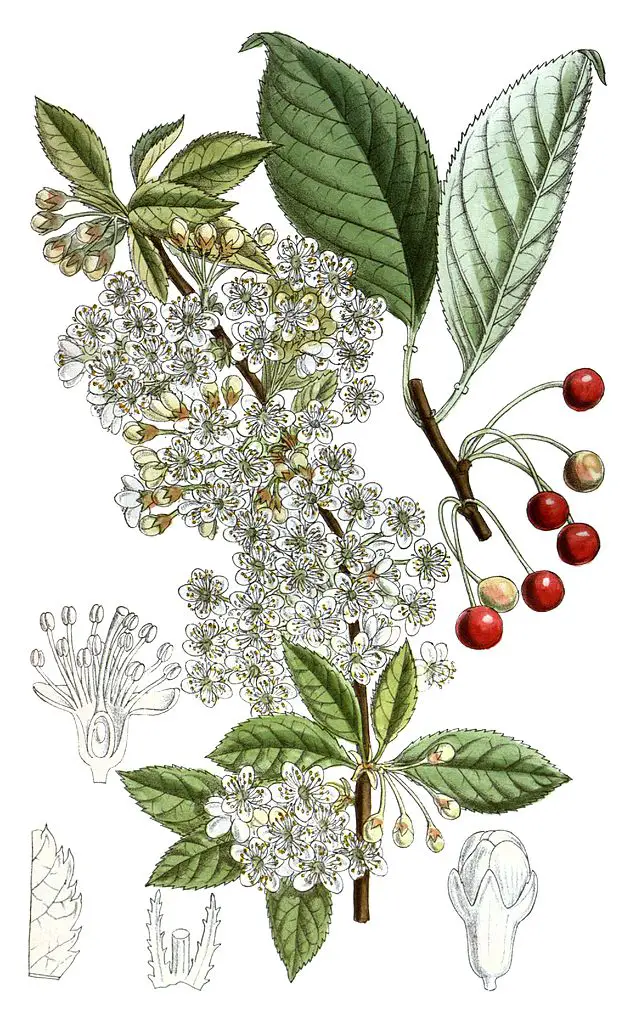
Pin Cherry (Prunus pensylvanica) illustration. (By: M.S. del, J.N.Fitch, lith.)
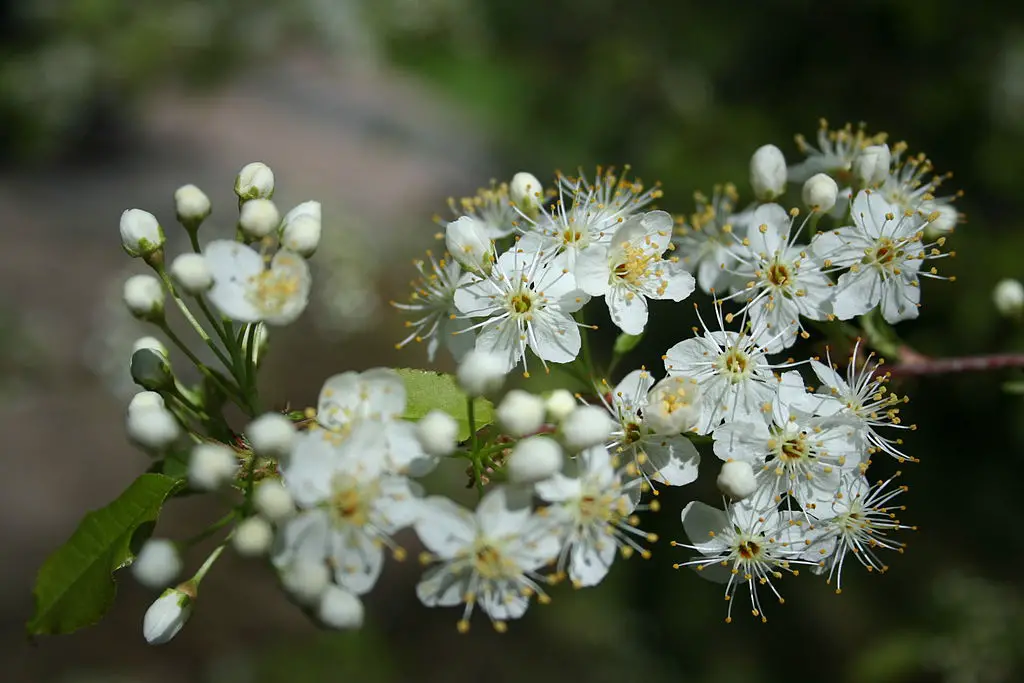
Pin Cherry (Prunus pensylvanica) flowers. (By: Halava CC BY-SA 3.0)
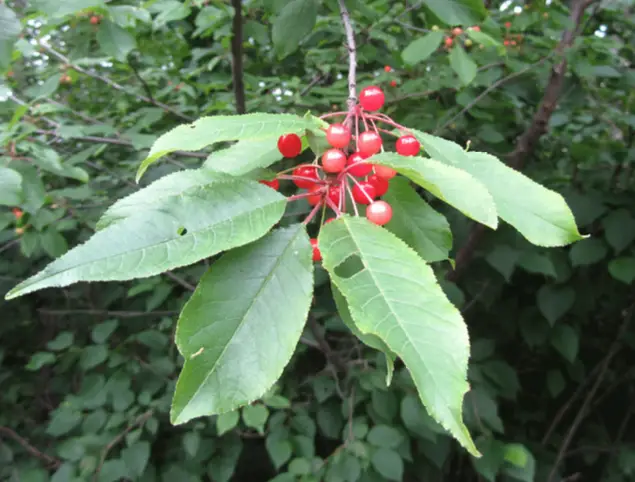
Pin Cherry (Prunus pensylvanica) cherries. (By: Homer Edward Price Attribution 2.0 Generic)
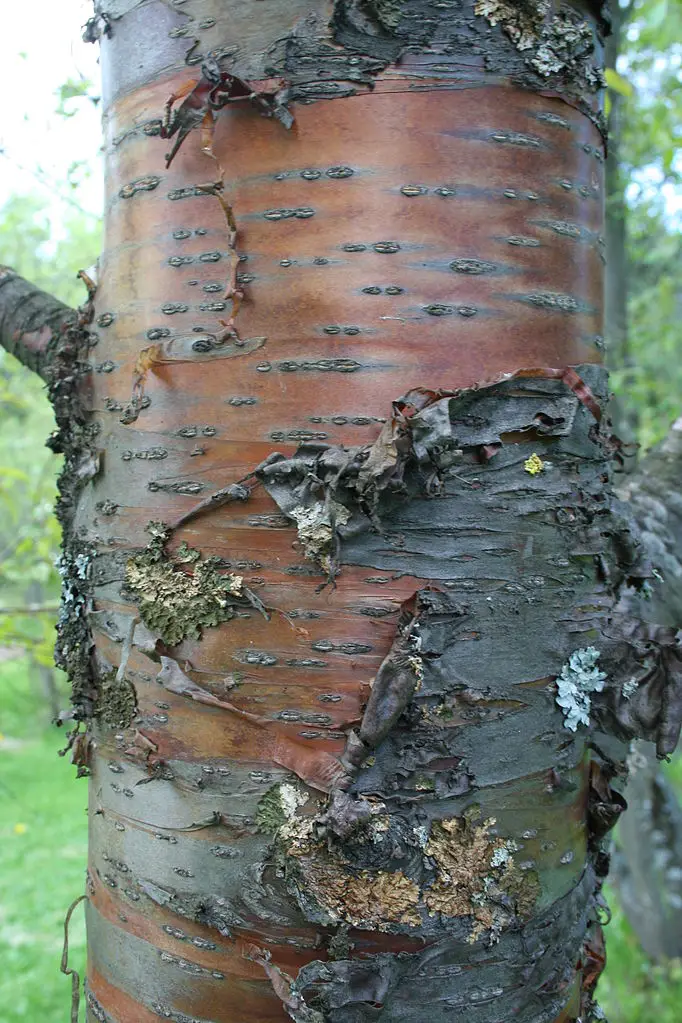
Pin Cherry (Prunus pensylvanica) bark. (By: Halava CC BY-SA 3.0)
Sand Cherry
Sand Cherry (Prunus pumila). Native to North America, found most commonly around Great Lake region in sand dunes. If you find one Sand Cherry bush (low to ground), look around, you will probably find many more - they tend to form what are known as clonal colonies, that is, there are whole patches of them that are basically the same plant spreading over a large area. It keeps sending shoots out from the roots. There are a few varieties of this Cherry, the only one I know is the Prunus pumila L. var. pumila, the Great Lakes Sand Cherry. It's a good name, as I've only encountered them when on sand dunes or gravel right by Lake Huron or Erie. Cherries are about 13-15 mm (1/2 to 3/5 inch) diameter, dark purple to almost black in color and is an early Cherry - ready to eat in early summer.
If you have a rocky, gravely, or sandy spot on your property this might be a good one to try. You would need to find a ripe cherry from one and plant it where you want. Since it forms clonal colonies, it shouldn't be hard to transplant, as long as you transplanted it in the fall after it went dormant for the season. Since you would have to cut some roots, cut back the branches as well to balance it out, and put less strain on the root system. I personally have never seen these for sale at tree nurseries.
I've got one of the Purple Leaf Sand Cherries in my yard, and have had it for years. It flowers faithfully each spring, but it has never produced a single cherry. I don't know if this is normal for this one, but I can't recommend this type based on my experience if you want it for fruit.
Description:
- USDA Plant Hardiness Zone: 2-8 (More information on hardiness zones).
- Soil pH: 4.5-7.5
- Plant Size: Shrub that forms clonal colonies. Normally 10-50 cm (4 to 20 inches) tall, but can be known to get to 3 meters (10 feet) - depends on variety and habitat
- Duration: Can live many years
- Leaf Shape: narrow Elliptic
- Leaf Phyllotaxis (Arrangement) on branch: Alternate
- Leaf Size: 4-7 cm (1 5/8 to 2 3/4 inches) long
- Leaf Margin: Serrated (saw toothed edge)
- Leaf Notes: Usually have light green leaves that can have a slight bluish or yellowish hue, some varieties have reddish leaves, leaf veins stand out clearly
- Flowers: Small, five petalled white flowers in clusters of 2-4
- Fruit: 13-15 mm (1/2 to 3/5 inch) diameter, dark purple to almost black in color, ready in early summer
- Bark: The younger branches are reddish, older ones grey.
- Habitat: Open, sandy areas like dunes, rocky areas, steep sandy hills, limestone gravel areas, salty areas - again, depends on local species. Sometimes in unused gravel pits, and in gravel along rail lines.
Web Resources:
- Recipe search on the web here (Google search) and here (Bing search).
- Pictures on the web here (Google images) and here (Bing images).
- Interactive USDA distribution map and plant profile here.
- The Biota of North America Program (BONAP) distribution map here. BONAP map color key here.
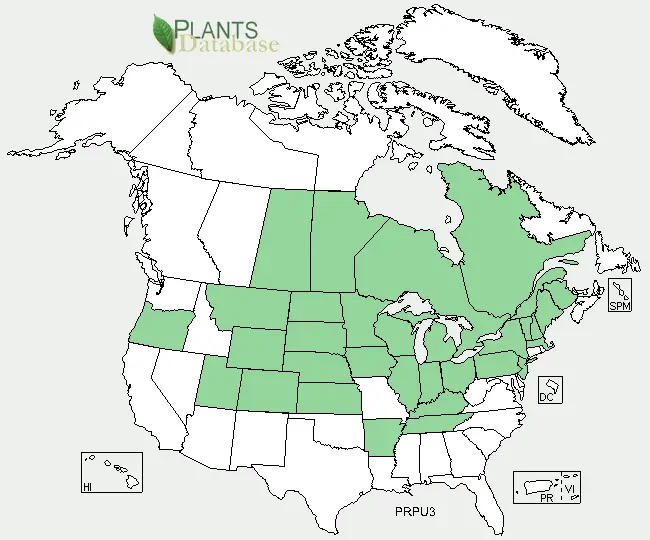
Sand Cherry (Prunus pumila) range. Distribution map courtesy of U. S. Department of Agriculture (USDA Natural Resources Service) and used in accordance with their policies.
Sand Cherry (Prunus pumila). This one is from around the Great Lakes. (By: Super cyclist)
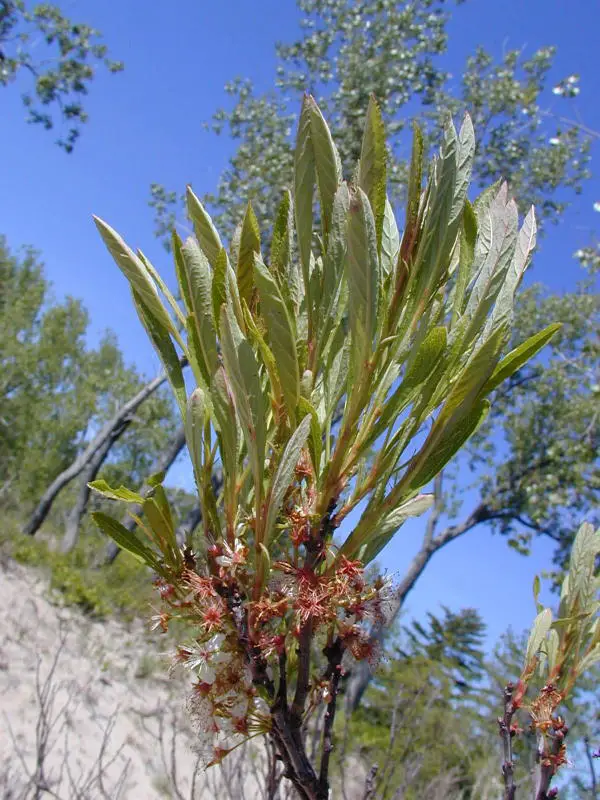
Great Lakes Sand Cherry (Prunus pumila var pumila). This is the variant that is common on sand dunes around the Great Lakes. (By: Troy Weldy)
.jpg)
Sand Cherry (Prunus pumila) flowers. (By: Superior National Forest Attribution 2.0 Generic)
Sour Cherry
Sour Cherry (Prunus cerasus). Native to Europe and Asia and now naturalized in North America. This is the Cherry that is popular for its health properties. A very nice looking tree, and the Cherries themselves, are classic "Cherry" looking. There is the bright red, or red with a hint of orange Amarelle Cherry, and the darker red Morello Cherry. The Cherries grow in clusters on the ends of the twigs and further up in clusters. This tree has beautiful, showy white flowerings in the spring. There are numerous cultivars of this tree. This is the Cherry that used most often for baked goods and jams. When raw, there is the mouth puckering quality of most native North American Cherries, but like the native species, that goes away when cooked. Very commonly found as wild trees.
You could plant a pit from a Sour Cherry or you could easily buy this tree from a nursery. There are many varieties that exist, but the two you are mostly likely to find are the Morello and the Amarelle. Keep in mind, although a nice tree with beautiful flowers in the spring, it does not live a long time. It does start to produce fruit very quickly, and you should have fruit the second year after planting a tree from a nursery that is over five feet tall.
Description:
- USDA Plant Hardiness Zone: 3-9 (More information on hardiness zones).
- Soil pH: 5.5-8.0 (Ideal: 6.5)
- Plant Size: 4–10 meters (13 to 33 feet) tall
- Duration: 20-25 years
- Leaf Shape: Ovate
- Leaf Phyllotaxis (Arrangement) on branch: Alternate
- Leaf Size: 5-13 cm (2 to 5 inches) long
- Leaf Margin: Serrated (saw toothed edge) to Double Serrated (small sawteeth on each larger sawtooth)
- Leaf Notes: Leaves are toxic.
- Flowers: White to light pink, five petalled in clusters
- Fruit: 2 cm (3/4 inch) diameter
- Bark: Young stems are grey-brown to reddish-brown with white spots, older bark is grey-brown to reddish-brown with dark grey lenticels (checking), on mature trunks the bark is dark grey-brown to reddish-brown, with vertical fissures that are curled up at the edges, but the lenticels (checking) is still there between the vertical fissures.
- Habitat: Native to Europe and Southwest Asia, has naturalized all over North America. Very often planted in cites and rural areas.
Web Resources:
- Recipe search on the web here (Google search) and here (Bing search).
- Pictures on the web here (Google images) and here (Bing images).
- Interactive USDA distribution map and plant profile here.
- The Biota of North America Program (BONAP) distribution map here. BONAP map color key here.
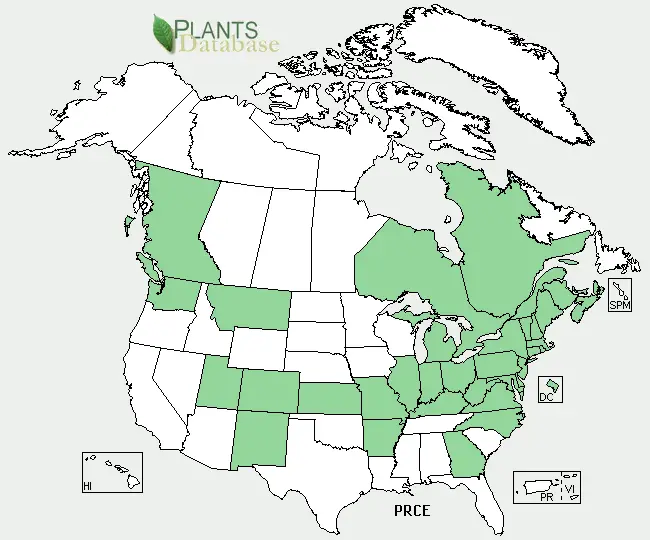
Sour Cherry (Prunus cerasus) range. Distribution map courtesy of U. S. Department of Agriculture (USDA Natural Resources Service) and used in accordance with their policies.
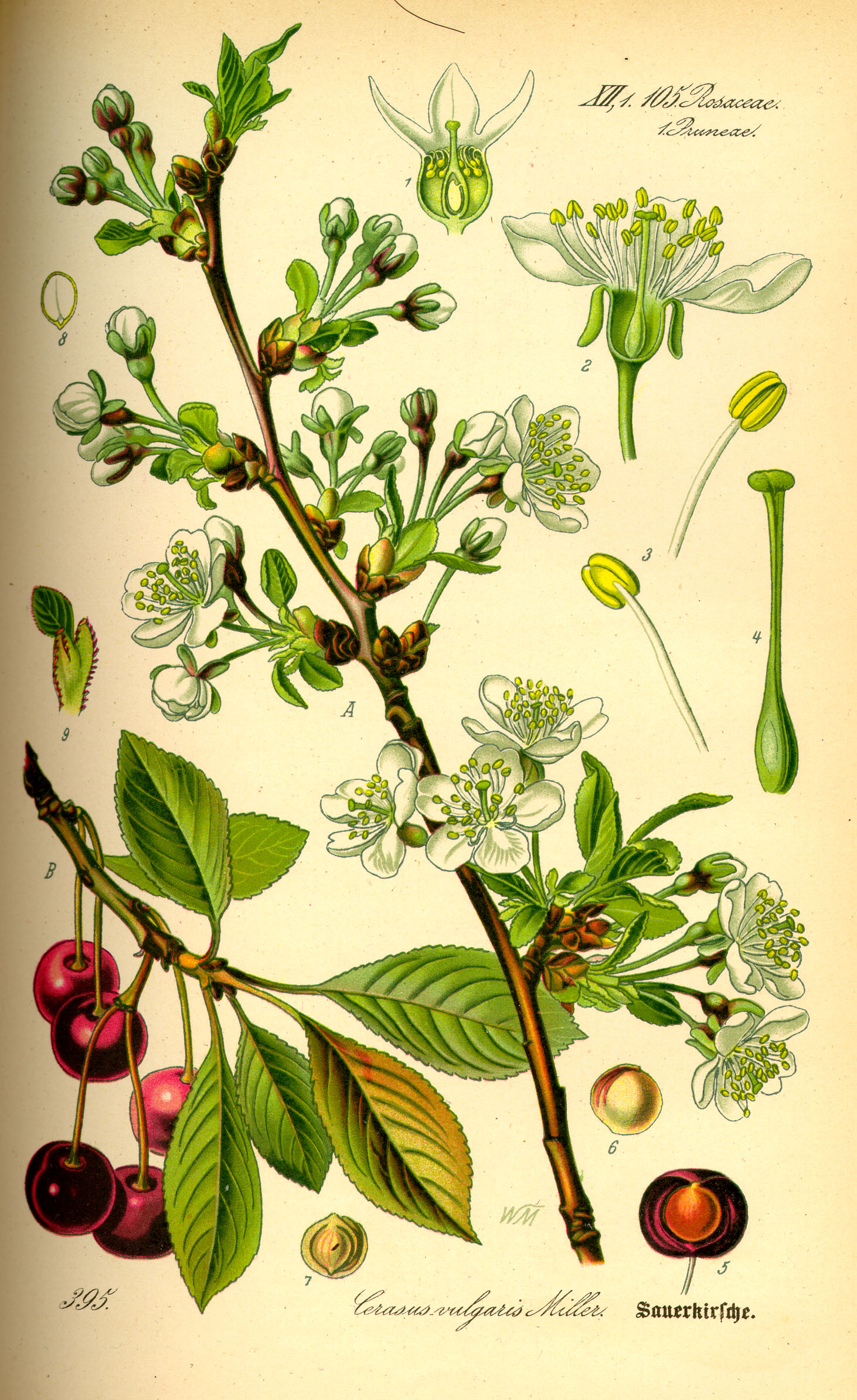
Sour Cherry (Prunus cerasus) illustration. The detail in this is truly amazing. (By: Prof. Dr. Otto Wilhelm Thomé Flora von Deutschland, Österreich und der Schweiz 1885, Gera, Germany)
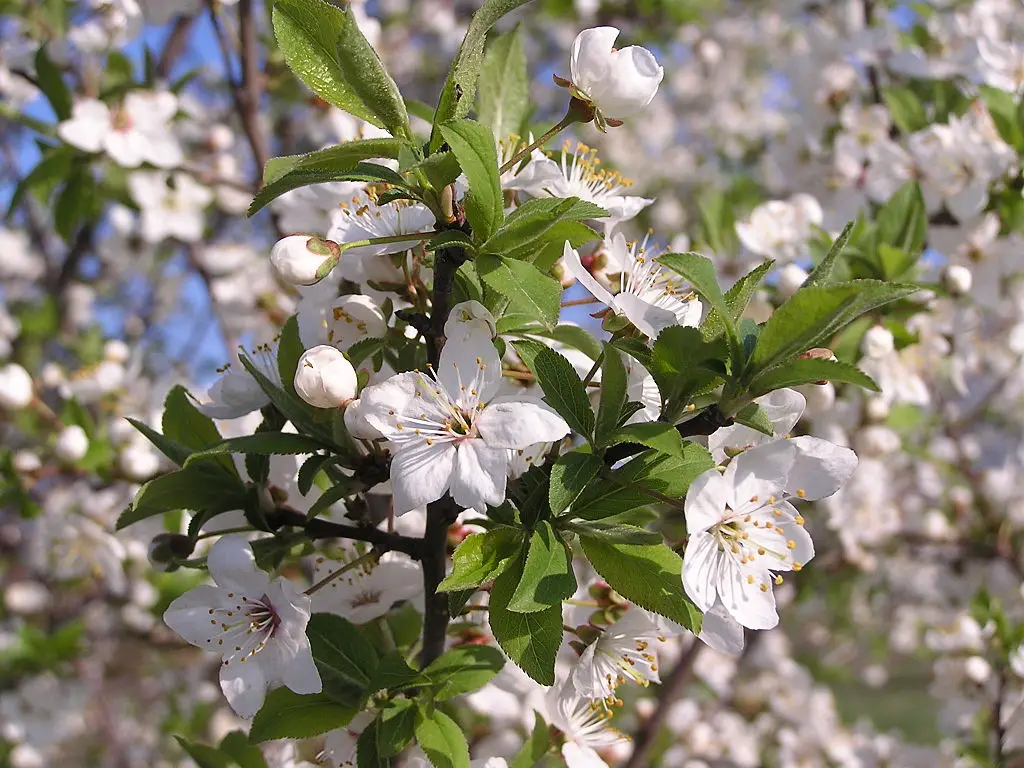
Sour Cherry (Prunus cerasus) in flower. (By: Andrew Butko CC BY-SA 3.0)
Sour Cherry (Prunus cerasus) leaves and fruit. (By: böhringer friedrich Attribution-Share Alike 2.5 Generic)
Sour Cherry (Prunus cerasus) leaf up close. (By: Walter Siegmund GNU Free Documentation License, Version 1.2)
Sweet Cherry or Wild Cherry
Sweet Cherry or Wild Cherry (Prunus avium). Native to Europe, Asia and Africa and now naturalized in North America. There are many variations (cultivars) of the Sweet Cherry, and many have naturalized in eastern North America, so it is not uncommon to find them in the wild. This is the tree that most of the Sweet Cherries sold in stores are from - it is the least tart of all the Cherries. Every part of this tree is toxic except for the ripe red flesh of the Cherry. This Cherry very often is in pairs on the tree - the stem of each Cherry meets at the tree. Even if there is a cluster, very often they come off in pairs. This tree is easy to recognize from the bark. It is brown with a purplish hue (sometimes with a hint of orange) and very noticeable brownish grey horizontal lenticels (checking) when the tree is young. When older, the lenticels become thick and dark blackish-brown, often splitting open. One very distinguishing feature of this tree is, just where the stem of the leaf meets the leaf bottom, there are two little red dots - glands. The leaves are downy underneath and almost shiny on the top - and like all Cherries, the edges of the leaf are sawtooth. I find this tree all over in the Carolinian areas of Ontario, along old fence lines, in woods and fields. If I didn't know better, I'd bet it was a native tree it is so common. Often hard to find any of the Cherries, as birds very often clean the trees out - hence the Latin name of the tree: Prunus "avium".
It will take a few years before you get fruit, but this tree can live longer than most Cherries. You can also find this tree at nurseries that, if they take well, will produce fruit much sooner than from a pit.
Description:
- USDA Plant Hardiness Zone: 5-8 (More information on hardiness zones).
- Soil pH: 5.5-8.0
- Plant Size: 15–32 meters (50 to 100 feet) tall, can get to 1.5 meters (5 feet) in diameter
- Duration: Up to 100 years, but can reach full height long before
- Leaf Shape: Ovate with a pointed tip
- Leaf Phyllotaxis (Arrangement) on branch: Alternate
- Leaf Size: 7–14 cm (3 to 6 inches) long and 4–7 cm (2 to 3 inches) wide
- Leaf Margin: Serrated (saw toothed edge) to Double Serrated (small sawteeth on each larger sawtooth)
- Leaf Notes: Has two small oval red (sometimes green or red and green) dots (glands) on the leaf stem just under the bottom of the leaf - very distinct. I have read they can have more than two glands (up to five) per leaf, but I have never seen that. Downy underneath and almost shiny on the top.
- Flowers: Five petalled, white flowers in clusters. Flowers are 2.5-3 cm (1 to 1 1/4 inches) diameter
- Fruit: approximately 8-12 mm diameter.
- Bark: Brown with purple hue, horizontal grey-brown lenticels (checking) on young to medium aged bark, mature bark is dark blackish-brown and fissured vertically, often has thin, curling back bark
- Habitat: Native to Europe and Asia, planted all over North America, and naturalized in many areas. Grows in a wide variety of conditions, but prefers well drained, moist, rich soils.
Web Resources:
- Recipe search on the web here (Google search) and here (Bing search).
- Pictures on the web here (Google images) and here (Bing images).
- Interactive USDA distribution map and plant profile here.
- The Biota of North America Program (BONAP) distribution map here. BONAP map color key here.
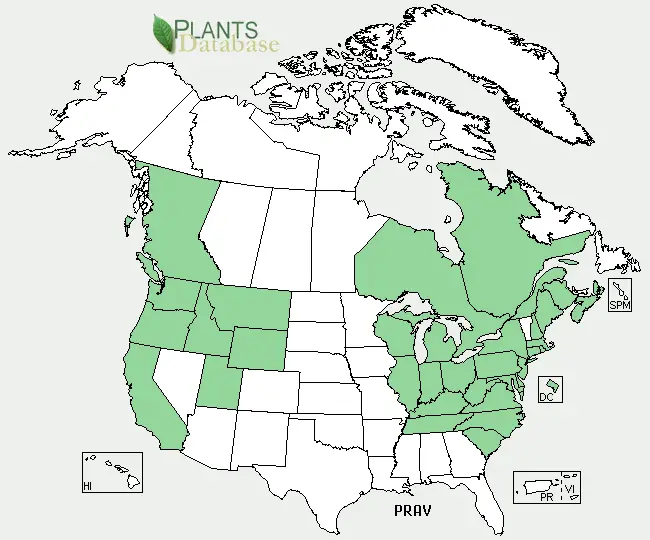
Sweet Cherry or Wild Cherry (Prunus avium) range. Distribution map courtesy of U. S. Department of Agriculture (USDA Natural Resources Service) and used in accordance with their policies.
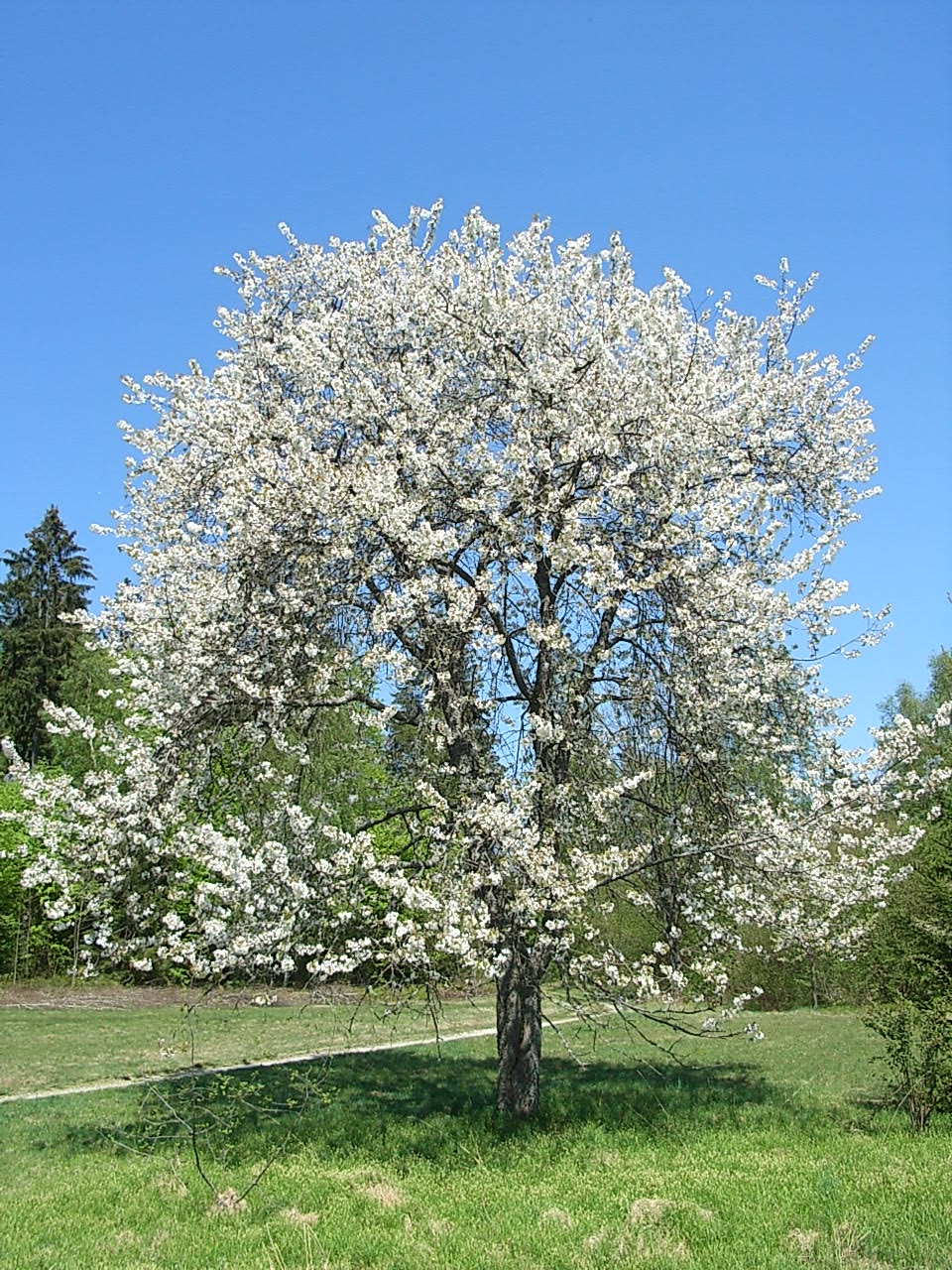
Sweet Cherry or Wild Cherry (Prunus avium) tree. (By: Konrad Lackerbeck Attribution-Share Alike 2.5 Generic)
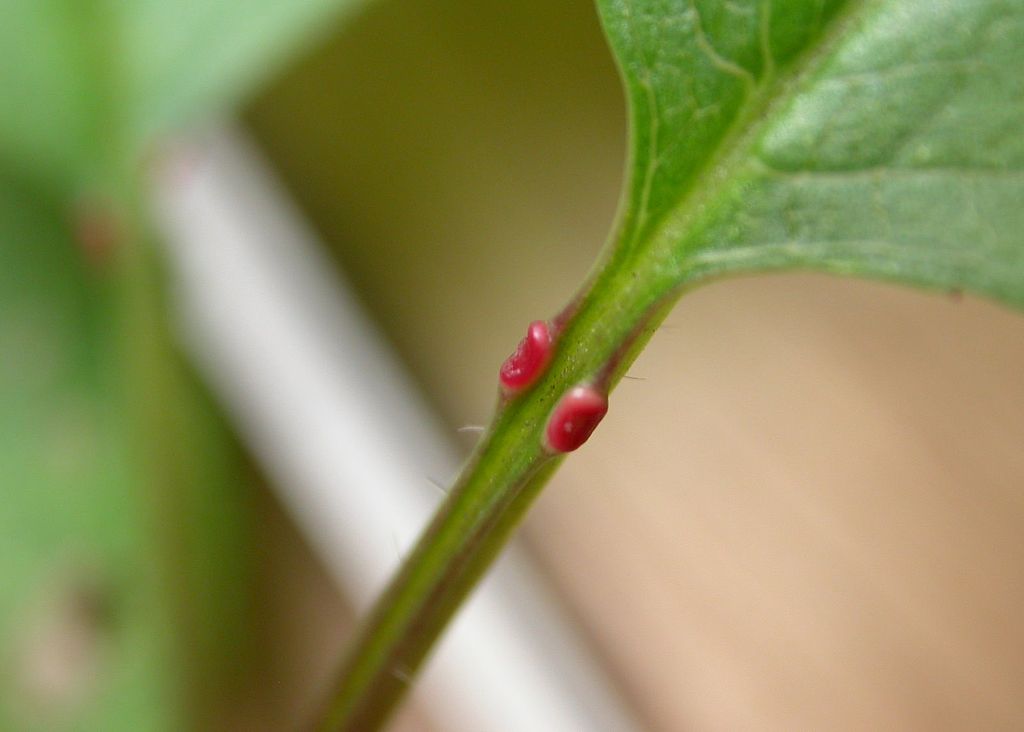
Sweet Cherry or Wild Cherry (Prunus avium) leaf glands. This is the best way to confirm or deny this is a Sweet Cherry tree by checking for these glands on the leaf stem near where the leaf blade starts. (By: André Abrahami Attribution-Share Alike 2.5 Generic)
Sweet Cherry or Wild Cherry (Prunus avium) blossoms. (By: Andrei Stroe CC BY-SA 3.0)
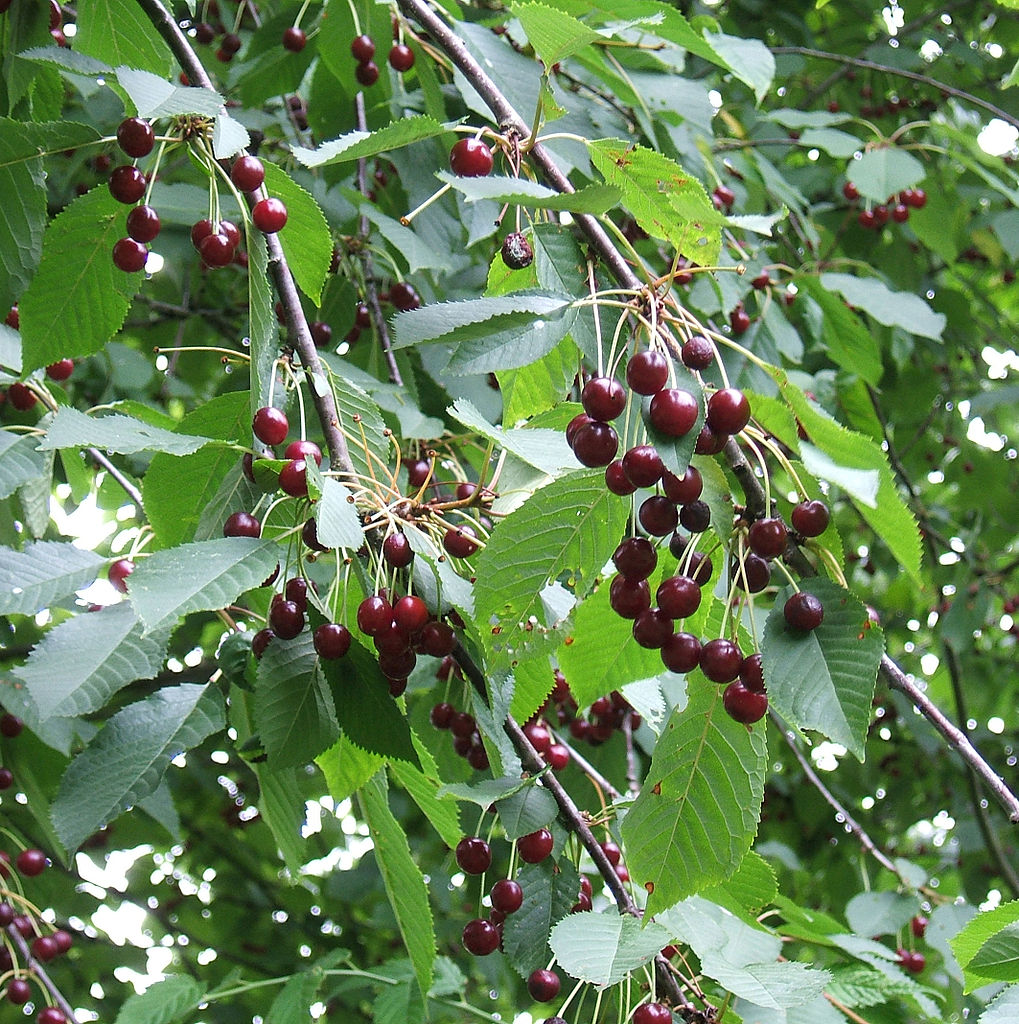
Sweet Cherry or Wild Cherry (Prunus avium) cherries. (By: MPF CC BY-SA 3.0)
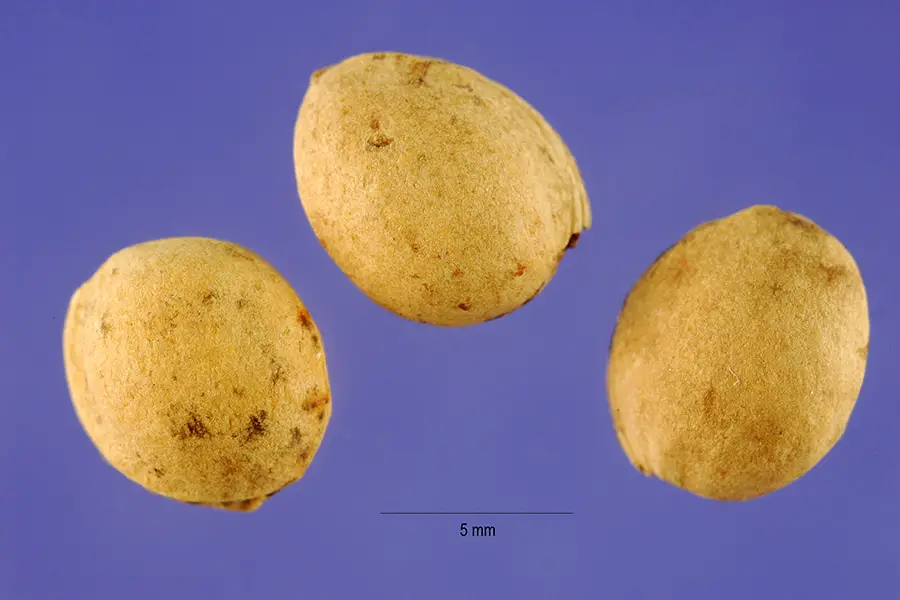
Sweet Cherry or Wild Cherry (Prunus avium) seeds/pits. (By: Steve Hurst, hosted by the USDA-NRCS PLANTS Database)
Canada Plum or Black Plum
Canada Plum or Black Plum (Prunus nigra). Native to North America. This is a small, crooked, irregular looking tree that has zig-zag shaped branches. The leaf is a fat looking oval with a drawn out pointed end. This tree often has thorns on it. The Plum has reddish-orange skin with yellow, juicy flesh. Some find it too sour, some like it. I like a little fresh, but not a lot. Most common use for the fruit is for making Plum jam. It can also be dried and stored. The Plum is about 2.5cm (1 inch) diameter, or sometimes just a bit larger. Expect to find this Plum in August and early September. Even though it is most common in Southern Ontario where I live, I don't see it that often, because right where I live there isn't any limestone close to the surface. When I travel to areas where there is limestone, I see it often in fields and along fence lines. Very often I see it on limestone hills like the Niagara Escarpment in open sections where bigger trees don't do as well. If it is happy where it is growing, it will form thickets. Because of the thorns on some of these, and the thickets, it can be a chore to harvest the fruit.
You could grow this at home from the pit if you have the right conditions, but I think there are better choices of Plum species unless you just want this one because you like the jam you can make from it or for the showy pink spring flowers. I doubt you would find this one at a nursery as the fruit is small, it often grows thorns and it only lives to around 20 years, though you may find the purple leaf varieties. I'm not sure what the fruit is like on the purple leaf variety.
Description:
- USDA Plant Hardiness Zone: 2-9 (More information on hardiness zones).
- Soil pH: 5.5-8.0
- Plant Size: Small tree or large Shrub up to 10 metres (33 feet) tall
- Duration: Lives about 20 years
- Leaf Shape: Ovate to Elliptic with thin pointy tip
- Leaf Phyllotaxis (Arrangement) on branch: Alternate
- Leaf Size: 5–12 cm (2 to 4 3/4 inches) long and 3–7 cm (1 1/5 to 2 4/5 inches) wide
- Leaf Margin: Double Serrated (saw toothed edge). That is, each large sawtooth has two little ones.
- Leaf Notes: Dull, dark green, there are purple-red leafed varieties
- Flowers: Single, white to light pink, five petalled flower.
- Fruit: Reddish-orange skin with yellow, juicy flesh, sour tasting but edible, sour quality goes away when cooked into jams, etc. About 2.5 cm (1 inch) diameter or slightly larger
- Bark: The bark is black with long, grey lenticels (checks). When the tree is more mature, often the bark splits open vertically, and peels back at the edges revealing the bark underneath which turns scaly, often has thorns
- Habitat: Open, full sun, alluvial soils. I have seen it most often in soils over limestone rock that have limestone gravel in them.
Web Resources:
- Recipe search on the web here (Google search) and here (Bing search).
- Pictures on the web here (Google images) and here (Bing images).
- Interactive USDA distribution map and plant profile here.
- The Biota of North America Program (BONAP) distribution map here. BONAP map color key here.
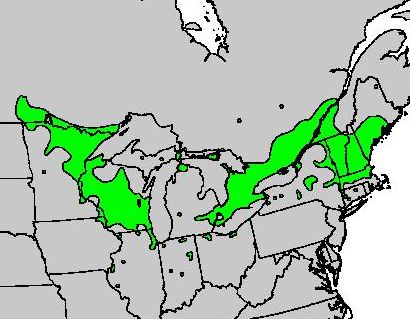
Canada Plum or Black Plum (Prunus nigra) range. Distribution map courtesy of the USGS Geosciences and Environmental Change Science Center, originally from "Atlas of United States Trees" by Elbert L. Little, Jr. .
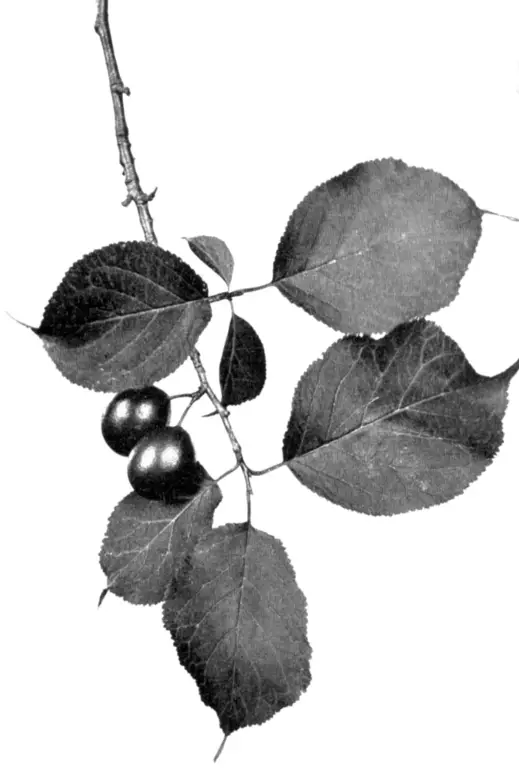
Canada Plum or Black Plum (Prunus nigra). leaves and fruit. Note the thorns. (By: Harriet L. Keeler)
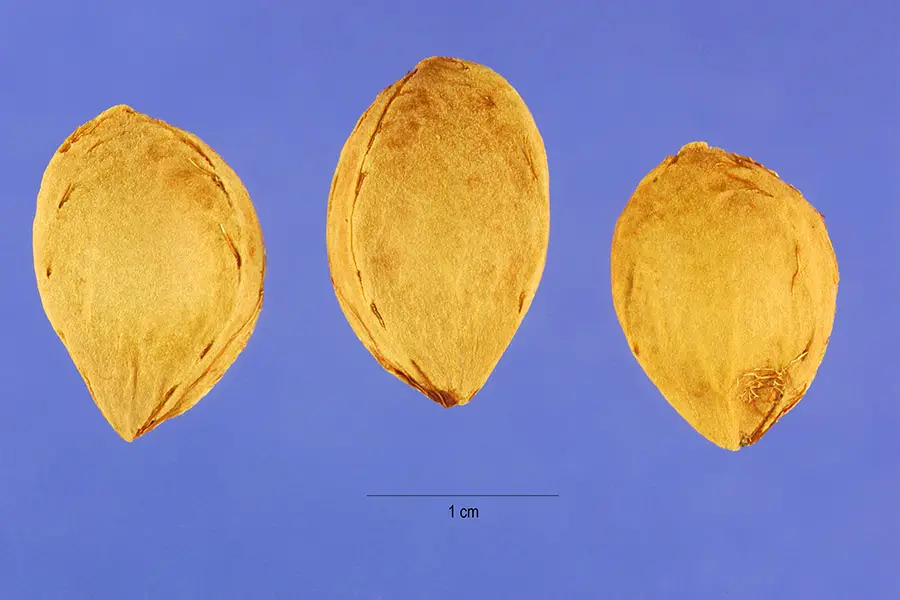
Canada Plum or Black Plum (Prunus nigra) seed/stone. (Steve Hurst, hosted by the USDA-NRCS PLANTS Database)
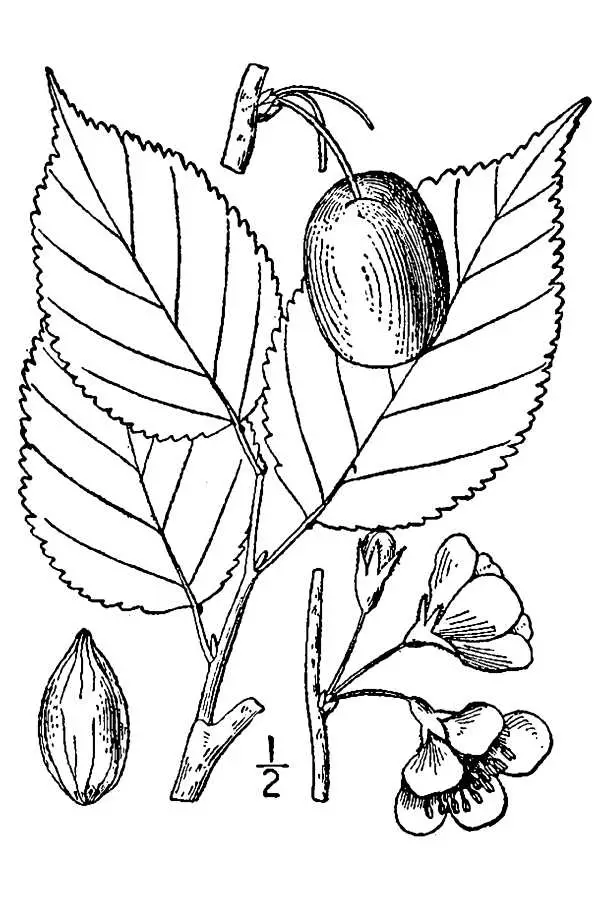
Canada Plum or Black Plum (Prunus nigra) drawing. (USDA-NRCS PLANTS Database / Britton, N.L., and A. Brown. 1913. An illustrated flora of the northern United States, Canada and the British Possessions. 3 vols. Charles Scribner's Sons, New York. Vol. 2: 323.)
American Plum or Wild Plum
American Plum or Wild Plum (Prunus americana). Native to North America. The American Plum likes wetter areas, such as beside wetlands, and edges of creeks and rivers. The orange to red Plum is ripe in August or early September. Careful when picking, this tree has thorns. There are many, many varieties of this tree, and some produce sweet fruit, some sour. Like the Canada Plum, the trunk has lenticels (checks). The bark is brown with a hint of red to grey. It too will have vertical splits in the bark that peel back. The bark exposed will get a scaly look. The tree is not tolerant of shade, and in the right conditions will send up suckers and form thick areas of very dense growth, often utilized for its ability to act as a wind break.
You can grow this one by planting a pit, but it will take a long time to produce fruit. The best way is by transplanting one that has come up from root suckers from a mother plant nearby or, if you can, get one from a nursery. This plant does not like compact soils or soils that are composed of fine materials - like clay for instance. It likes gravely, or coarse sandy, light loam soils only. It likes moist soil, but will tolerate short droughts.
Description:
- USDA Plant Hardiness Zone: 3-8 (More information on hardiness zones).
- Soil pH: 5.5-7.5
- Plant Size: Small tree or large Shrub that can grow up to 5 meters (16 feet) tall
- Duration: Many years, since it forms thickets from root suckers, the life span of the thicket can far outlive the mother shrub
- Leaf Shape: Ovate with pointed tip
- Leaf Phyllotaxis (Arrangement) on branch: Alternate
- Leaf Size: 5-13 cm (2 to 5 inches) long
- Leaf Margin: Serrated (saw toothed edge)
- Leaf Notes: The top of the leaf is dark green, the bottom is lighter green and smooth
- Flowers: Come from leaf axils (where leaf stem meets twig). Single to clusters of flowers, small white, five petalled
- Fruit: 3 cm or bit more (1 1/4 inches) diameter
- Bark: Young bark: smooth, shiny, brown. Mature bark: grey-brown with scales and outermost bark peeling (curled back)
- Habitat: Very adaptable to a wide variety of conditions. Tolerates acidic to mildly alkaline soils, can withstand a little shade in wooded areas, but needs sun for part of the day. Likes soils that are coarse with gravel, sand that are not hard and compacted. Most likely to be found in the wild along rivers, streams, by wetlands, edges of woods, but is planted (and does well) in drier areas. Common use is for windbreak hedge rows.
Web Resources:
- Recipe search on the web here (Google search) and here (Bing search).
- Pictures on the web here (Google images) and here (Bing images).
- Interactive USDA distribution map and plant profile here.
- The Biota of North America Program (BONAP) distribution map here. BONAP map color key here.
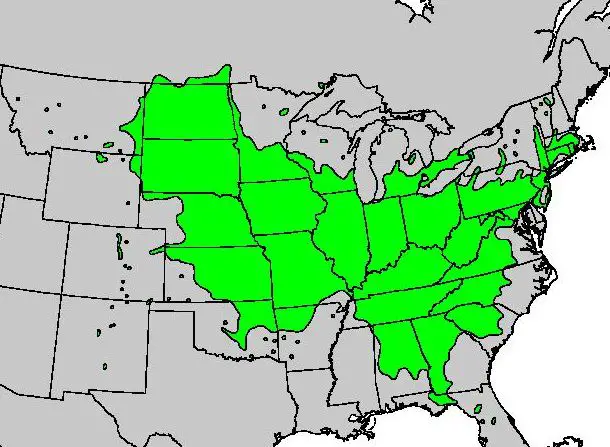
American Plum or Wild plum (Prunus americana) range. Distribution map courtesy of the USGS Geosciences and Environmental Change Science Center, originally from "Atlas of United States Trees" by Elbert L. Little, Jr.
American Plum or Wild plum (Prunus americana) tree. (By: Аимаина хикари Creative Commons CC0 1.0 Universal Public Domain Dedication)
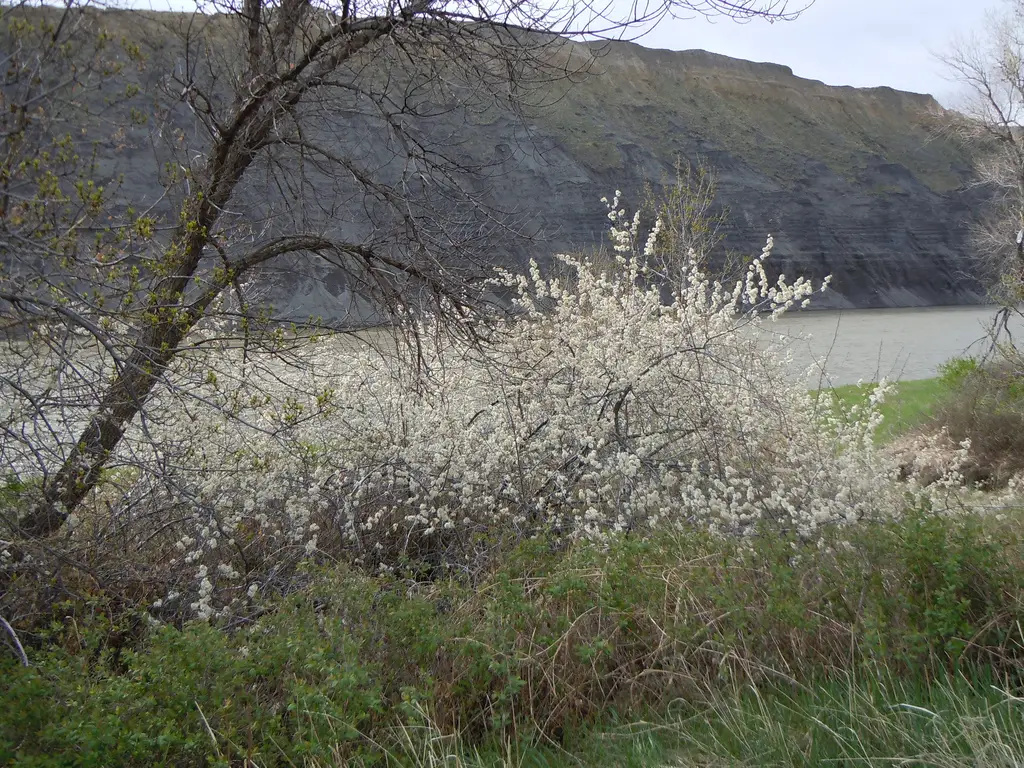
American Plum or Wild plum (Prunus americana) in flower. (By: Matt Lavin Attribution 2.0 Generic)
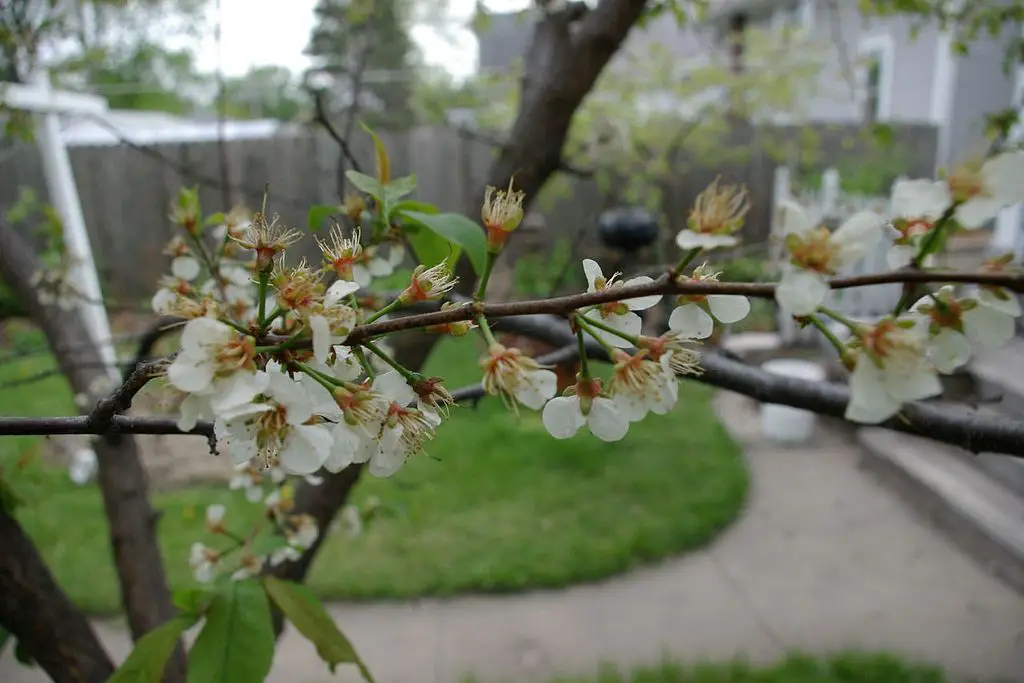
American Plum or Wild plum (Prunus americana) blossoms. (By: Andrew Ciscel Attribution 2.0 Generic)
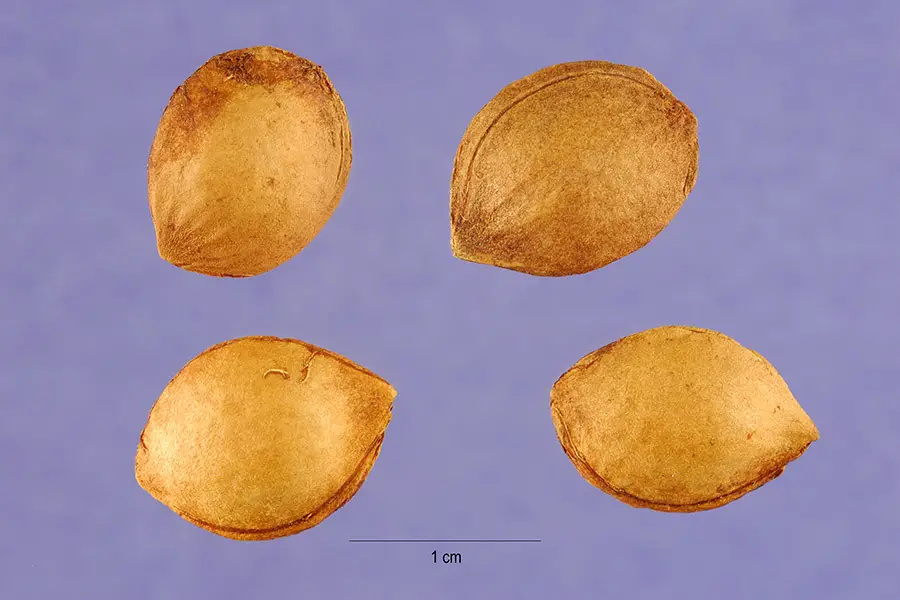
American Plum or Wild plum (Prunus americana) seed/stone. (Steve Hurst, hosted by the USDA-NRCS PLANTS Database)
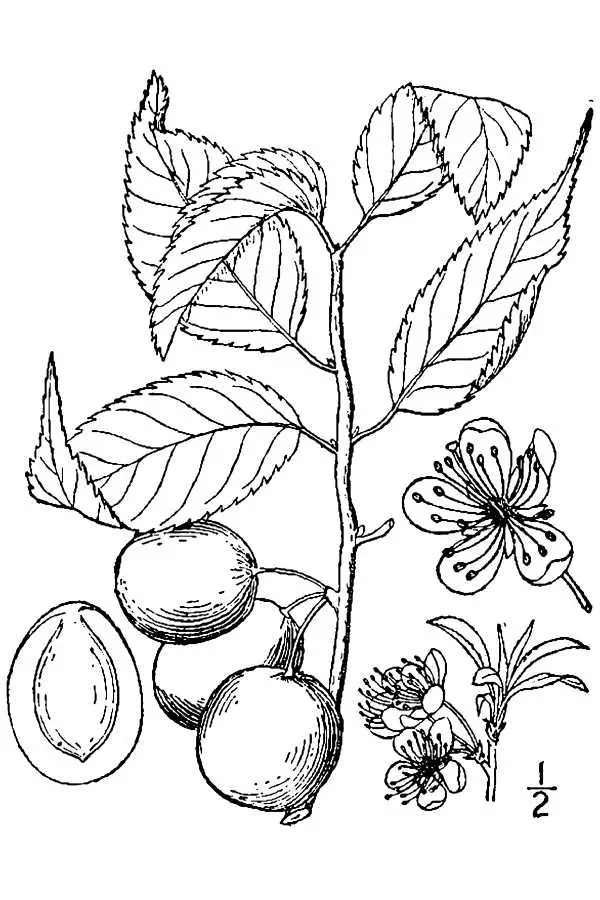
American Plum or Wild plum (Prunus americana) drawing. (USDA-NRCS PLANTS Database / Britton, N.L., and A. Brown. 1913. An illustrated flora of the northern United States, Canada and the British Possessions. 3 vols. Charles Scribner's Sons, New York. Vol. 2: 323.)
Search Wild Foods Home Garden & Nature's Restaurant Websites:
Share:
Why does this site have ads?
Originally the content in this site was a book that was sold through Amazon worldwide. However, I wanted the information to available to everyone free of charge, so I made this website. The ads on the site help cover the cost of maintaining the site and keeping it available.
Google + profile
